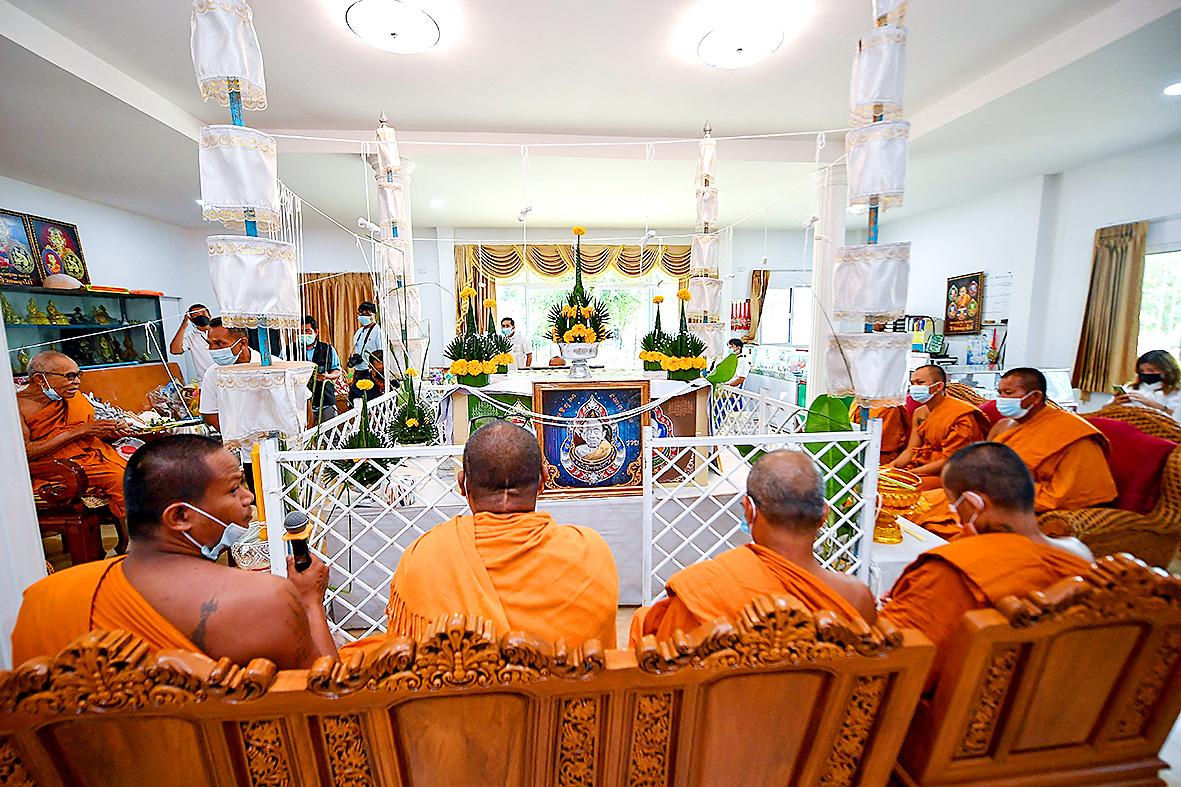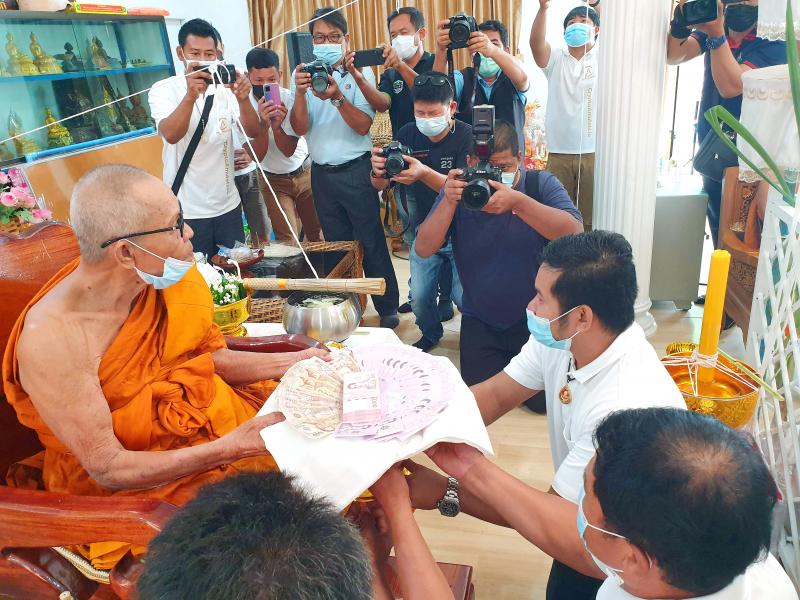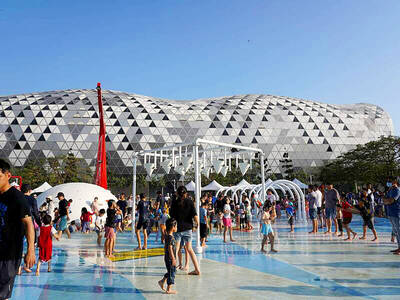Karmic fortune has arrived to the digital art market, with a kaleidoscopic splash of colors and the face of a revered Thai monk offering portable Buddhist good luck charms to tech-savvy buyers.
Sales of non-fungible tokens (NFTs) — virtual images of anything from popular internet memes to original artwork — have swept the art world in recent months, with some fetching millions of dollars at major auction houses. “CryptoAmulets” is the latest venture to chase the craze, with founder Ekkaphong Khemthong sensing opportunity in Thailand’s widespread practice of collecting talismans blessed by revered monks.
“I am an amulet collector and I was thinking about how I could introduce amulets to foreigners and to the world,” he said.

Photo: AFP
Collecting amulets and other small religious trinkets is a popular pastime in Buddhist-majority Thailand, where the capital Bangkok has a market solely dedicated to the traders of these lucky objects.
Their value can rise thousands of dollars if blessed by a well-respected monk.
Despite being a digital format, Ekkapong wanted CryptoAmulets to have the same traditional ceremony as a physical piece, which is why he approached Luang Pu Heng, a highly regarded abbot from Thailand’s northeast.

Photo: AFP
“I respect this monk and I would love the world to know about him — he is a symbol of good fortune in business,” he said.
AUTHENTIC AND BLESSED
Luang Pu Heng last month presided over a ceremony to bless physical replicas of the digital amulets, which show a serene image of his face.

Photo: AFP
He splashed holy water onto his own visage as his saffron-robed disciples chanted and scattered yellow petals on the altar where the portraits were mounted. One challenge was trying to explain the concept of NFTs to the 95-year-old abbot, who assumed he would be blessing physical amulets.
“It’s very hard so we just tried to simplify it,” said Singaporean developer Daye Chan. “We said to him that it’s like blessing the photos.”
Transforming amulets into crypto art also means the usual questions of authenticity plaguing a talisman sold in a market are eliminated, he added.
“There are so many amulets being mass produced... All the records could be lost and these physical items can be easily counterfeited,” Chan said.
NFTs use blockchain technology — an unalterable digital ledger — to record all transactions from the the moment of their creation.
“For our amulet, even a hundred years later, they can still check back the record to see what the blockchain is,” Chan said.
But founder Ekkaphong would not be drawn on the karmic effectiveness of digital amulets, compared to their real-life counterparts. “They are different,” he said.
‘LUCKY EXPERIENCES’
On the CryptoAmulets Web site online gallery, different inscriptions are written in Thai — “rich”, “lucky” or “fortunate”, for instance — around each of the tokens.
They are priced on a tiered system in ethereum, the world’s second-largest cryptocurrency after bitcoin, and are currently selling for between US$46 and US$1,840. Sales have been slow ahead of Sunday’s purchase deadline, with only 1,500 tokens sold out of the 8,000 available, and with Thais making up most of the buyers.
Thai chef Theerapong Lertsongkram said he bought a CryptoAmulet because of his reverence for objects blessed by Luang Pu Heng, which he says have brought him good fortune.
“I have had several lucky experiences such as winning small lottery prizes... or being promoted on my job,” said Theerapong, who works in a Stockholm restaurant.
“I did not know anything about NFTs before, but I made the decision to buy it as I respect Luang Pu Heng so much,” he said.
But fellow collector Wasan Sukjit — who adorns the interior of his taxi with rare amulets — has a harder time with the concept. “Amulets need to be something physical, something people can hold,” he scoffed. “I prefer the ones I can hang on my neck.”

The Taipei Times last week reported that the rising share of seniors in the population is reshaping the nation’s housing markets. According to data from the Ministry of the Interior, about 850,000 residences were occupied by elderly people in the first quarter, including 655,000 that housed only one resident. H&B Realty chief researcher Jessica Hsu (徐佳馨), quoted in the article, said that there is rising demand for elderly-friendly housing, including units with elevators, barrier-free layouts and proximity to healthcare services. Hsu and others cited in the article highlighted the changing family residential dynamics, as children no longer live with parents,

Oct 20 to Oct 26 After a day of fighting, the Japanese Army’s Second Division was resting when a curious delegation of two Scotsmen and 19 Taiwanese approached their camp. It was Oct. 20, 1895, and the troops had reached Taiye Village (太爺庄) in today’s Hunei District (湖內), Kaohsiung, just 10km away from their final target of Tainan. Led by Presbyterian missionaries Thomas Barclay and Duncan Ferguson, the group informed the Japanese that resistance leader Liu Yung-fu (劉永福) had fled to China the previous night, leaving his Black Flag Army fighters behind and the city in chaos. On behalf of the

I was 10 when I read an article in the local paper about the Air Guitar World Championships, which take place every year in my home town of Oulu, Finland. My parents had helped out at the very first contest back in 1996 — my mum gave out fliers, my dad sorted the music. Since then, national championships have been held all across the world, with the winners assembling in Oulu every summer. At the time, I asked my parents if I could compete. At first they were hesitant; the event was in a bar, and there would be a lot

The classic warmth of a good old-fashioned izakaya beckons you in, all cozy nooks and dark wood finishes, as tables order a third round and waiters sling tapas-sized bites and assorted — sometimes unidentifiable — skewered meats. But there’s a romantic hush about this Ximending (西門町) hotspot, with cocktails savored, plating elegant and never rushed and daters and diners lit by candlelight and chandelier. Each chair is mismatched and the assorted tables appear to be the fanciest picks from a nearby flea market. A naked sewing mannequin stands in a dimly lit corner, adorned with antique mirrors and draped foliage